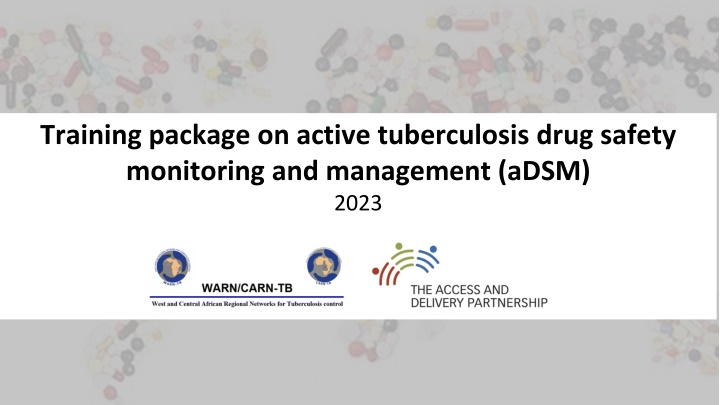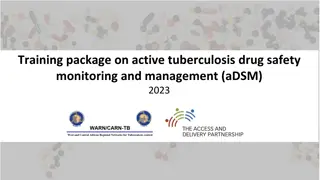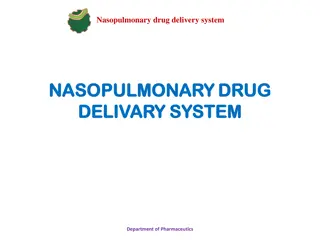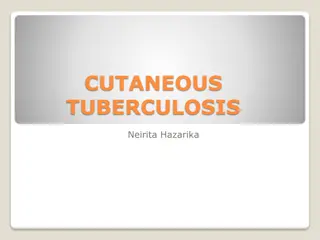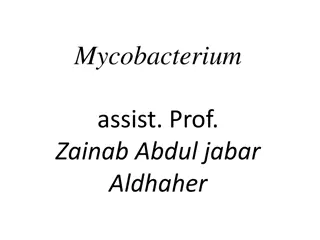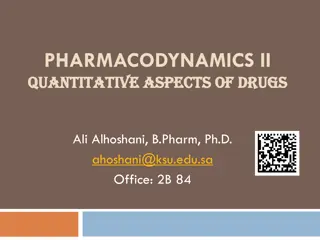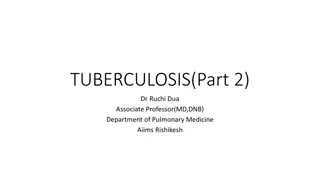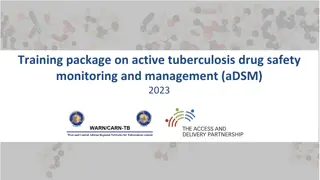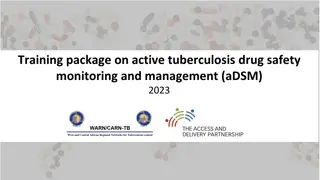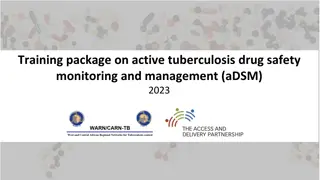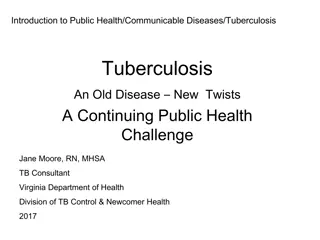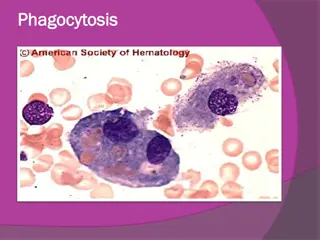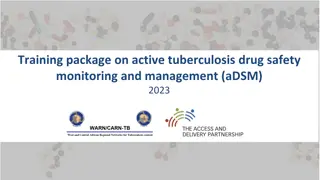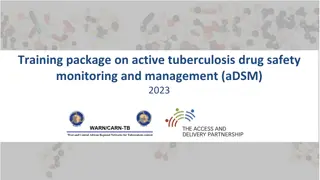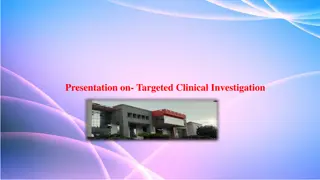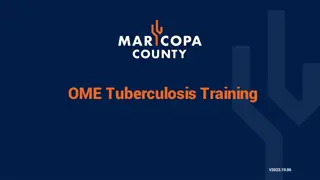Building Capacity for Active Tuberculosis Drug Safety Monitoring and Management
This training package focuses on developing capacity for signal detection and causality assessment in the management of active tuberculosis drug safety. Key steps include creating a national coordinating mechanism, defining roles and responsibilities, training staff, and consolidating data electronically. The learning objective is to understand how to undertake causality assessment and contribute to signal detection. Human resource development is emphasized through training plans and accessing expertise when needed.
Download Presentation

Please find below an Image/Link to download the presentation.
The content on the website is provided AS IS for your information and personal use only. It may not be sold, licensed, or shared on other websites without obtaining consent from the author.If you encounter any issues during the download, it is possible that the publisher has removed the file from their server.
You are allowed to download the files provided on this website for personal or commercial use, subject to the condition that they are used lawfully. All files are the property of their respective owners.
The content on the website is provided AS IS for your information and personal use only. It may not be sold, licensed, or shared on other websites without obtaining consent from the author.
E N D
Presentation Transcript
Training package on active tuberculosis drug safety monitoring and management (aDSM) 2023
2.1viii. Develop capacity for signal detection and causality assessment
Key steps in aDSM implementation Create a national coordinating mechanism for aDSM Develop a plan for aDSM Define management and supervision roles and responsibilities Create standard data collection materials Train staff on the collection of data Define schedules and routes for data collection and reporting Consolidate aDSM data electronically Develop capacity for signal detection and causality assessment
Learning objective By the end of this presentation, the participant is expected to Understand how to build capacity in-country to undertake causality assessment and contribute to signal detection
Definition of signal Reported information on a possible causal relationship between an AE and a TB medicine The relationship was previously unknown or incompletely documented (e.g. a new aspect of a known association) Signal detection is based on analyses of multiple data points
Introduction Building capacity will need a dual investment in human resource development, and facilities (location, equipment, consumables, infrastructure ) Needed to undertake causality assessment and signal detection within the health care services The aDSM plan needs to make provision for these coordinated activities and budget for them
Human resource development (1) training staff Based on the roles and responsibilities of the staff who will be carrying out the aDSM (see module 2.1iii), a training plan is drawn up with objectives and training material Appropriate experts will be needed to prepare for and undertake the training These experts may be present in the country (e.g. pharmacovigilance centre); if not the expertise may be accessed through technical partners
Human resource development (2) training as a trainer Familiarize yourself with the content of all modules Delegate the technical modules if not your specialty e.g. AE clinical management can be delegated to a medical doctor, key definitions to a specialist from the national pharmacovigilance structure Select commonplace examples from your context, for instance it is better to use scenarios of TB cases with HIV co-infection if you work in Central Africa region Leave space for questions and discussions
Facilities (1) conducive environment In order to undertake causality assessment and signal detection, the environment - (location, equipment, consumables, infrastructure etc. -> needs to be conducive for the workers to undertake the required tests (clinical and special tests) among target patients and to report the associated data appropriately If staff are trained to undertake causality assessment they need to be able to access special diagnostic facilities (e.g. have ECGs and calculation of the corrected QT interval) Beyond the first training, the staff need to have mentoring and access to specialist opinion to resolve any difficulties which they may have
Facilities (2) support to signal detection While causality assessment is primarily an activity which needs to happen at local level, for signal detection the pooling of data across different cohorts is expected given that new signals may be relatively uncommon. The primary rationale underpinning the creation of a global aDSM database is to unite safety reports from TB patients on treatment in different countries For staff from an individual country or subnational centre to participate effectively in the global database they will need to adhere to the reporting specifications and also to receive feedback on the relevance of their contribution to global knowledge
Conclusions Developing capacity for signal detection and causality assessment requires investment in the training and support of national staff The skills needed for staff to be able to establish causal links and determine the probability of an association are rooted in epidemiology and in drug safety In addition to training, the staff would need to count upon support from expert staff to answer to any difficulties which they may experience The facilities available - including equipment, consumables, and infrastructure - also need to be conducive to the required practice
Acknowledgements The development of the aDSM training material was funded by TDR as part of the Access and Delivery Partnership (ADP) with funding from the Government of Japan. These training materials were put together in 2016 the WHO Task Force on aDSM with technical partners KNCV Tuberculosis Foundation, Management Sciences for Health (SIAPS), MSF, WHO GTB, and TDR. The materials were updated in 2022-23 by Mahamadou Bassirou Souleymane (TDR consultant) with Marie-Eve Raguenaud (TDR), Branwen J Hennig (TDR), and Corinne Merle (TDR), and reviewed by Linh Nhat Nguyen (WHO/GTB), Medea Gegia (WHO/GTB), and Fuad Mirzayev (WHO/GTB). We thank all members of the WARN/CARN-TB working group on aDSM who contributed to the development of the aDSM generic guidelines as well as the secretariat, particularly Dr Christ Houessinon: Disadidi Ambrioso, Esse Marius, Adomou Jamal Rouamba Ruffine, Haro Sougrimani, Koumbem Boureima, Nsanzerugeze Jos lyne, Tollo Tollo Daniel Alphonse D sir , Mpaba Minkat Th ophile Mistral, Julie Abessolo, Ursule IDOKO, Tijan Baldeh , Wandifa Samateh, Tida S Kinteh, Alieu Wurie, Mardemn Yeasuen, Benjamin K. Quenneh, Cheick Oumar Bah, Kane El Hadj Malick, Aw Idriss, Mamoudou Hama Rachida, Gagara I. M. Assiatou, Katamb Balkissa, Seiyabatou ElhSaidou, Liombo Anastasie, Lunganyu Junior, Kitambala Sentime, Lula Yves , Habimana-Mucyo Yves, Migambi Patrick, dos Santos Brigite, Castro V nia, Wadson Cruz, Gueye Aminata, Mukeh Fahnbulleh, Bailor Samuel, Manjo Lamin, Saleh Mahareb Abdoulaye, Haroun Saleh Naima, Mouhoudine Yerima, Kpelafia Silifa
